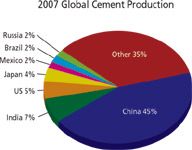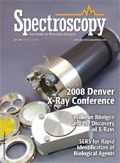Market Profile: Cement Analysis by XRF
X-ray fluorescence spectroscopy (XRF) is one of the primary analytical tools used in the cement industry for a variety of related applications. The principle of XRF is relatively simple; a source directs X-rays onto the atoms of the sample, ejecting electrons from the inner electron shells.
X-ray fluorescence spectroscopy (XRF) is one of the primary analytical tools used in the cement industry for a variety of related applications. The principle of XRF is relatively simple; a source directs X-rays onto the atoms of the sample, ejecting electrons from the inner electron shells. As electrons fall into the resulting holes, characteristic X-rays are released, which can be analyzed by a spectrometer to identify the elementary composition of the sample. The two main types of XRF instruments, energy dispersive (EDXRF) and wavelength dispersive (WDXRF), use different methods to analyze the X-ray spectrum. Generally speaking, WDXRF offers finer spectral resolution, but has a higher price tag.

2007 Global Cement Production
Despite the greater expense, WDXRF is indispensible in the cement industry. Samples include raw materials like sand and lime, finished cement products, and samples grabbed from the production process. The elemental composition of samples gives information about the purity of the sample, but also the state of oxidation of the cement, an important measure of quality. EDXRF is also used, typically in a supporting role, for the same types of applications. Samples are prepared either as pressed pellets or, for greater homogeneity, fused into a glass disk.
As an industry, cement is currently of enormous importance in Asia, which is home to more than two-thirds of both production and consumption of cement. China alone is responsible for about half the global market. This has some environmental implications as well, as China is now the largest global source of CO2 emissions, with cement production responsible for nearly 10% of the country's CO2 output.
Some of the foregoing data were extracted from SDi's market analysis and perspectives report entitled Global Assessment Report, 9th Edition: The Laboratory Life Science and Analytical Instrument Industry, September 2006. For more information, contact Michael Tice, VP of Consulting Services, Strategic Directions International, Inc., 6242 West-chester Parkway, Suite 100, Los Angeles, CA 90045, (310) 641-4982, fax: (310) 641-8851, www.strategic-directions.com.

AI Shakes Up Spectroscopy as New Tools Reveal the Secret Life of Molecules
April 14th 2025A leading-edge review led by researchers at Oak Ridge National Laboratory and MIT explores how artificial intelligence is revolutionizing the study of molecular vibrations and phonon dynamics. From infrared and Raman spectroscopy to neutron and X-ray scattering, AI is transforming how scientists interpret vibrational spectra and predict material behaviors.
Advancing Corrosion Resistance in Additively Manufactured Titanium Alloys Through Heat Treatment
April 7th 2025Researchers have demonstrated that heat treatment significantly enhances the corrosion resistance of additively manufactured TC4 titanium alloy by transforming its microstructure, offering valuable insights for aerospace applications.